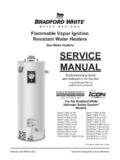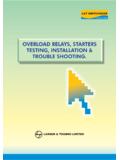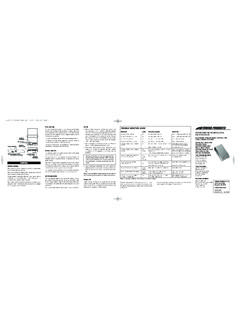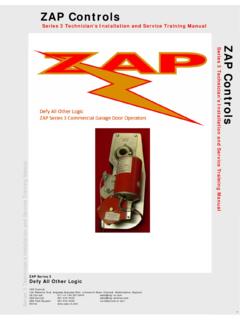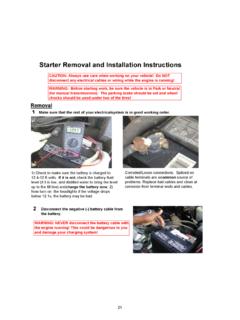Transcription of INSTALLATION AND OPERATION MANUAL For ... - Klaus …
1 1 INSTALLATION AND OPERATION MANUAL For PLASMA III, II+, and II CDI SYSTEMS FOUR AND SIX CYLINDER INSTALLATIONS CONGRATULATIONS ON YOUR PURCHASE OF A LIGHT SPEED ENGINEERING (LSE) PLASMA CAPACITOR DISCHARGE IGNITION (CDI) SYSTEM. YOU WILL NOW BE ABLE TO EXPERIENCE THE SIGNIFICANT ADVANTAGES OF DISTRIBUTORLESS HIGH ENERGY ELECTRONIC IGNITION IN FLIGHT PERFORMANCE AND EFFICIENCY. TO ENSURE RELIABLE LONG TERM OPERATION , AND TO ACHIEVE THE FULL PERFORMANCE POTENTIAL, PLEASE READ THE ENTIRE MANUAL CAREFULLY, AND FOLLOW THE PROCEDURES. SINCERELY, Klaus SAVIER, Light Speed Engineering, LLC LIGHT SPEED ENGINEERING, LLC MAIL: PO BOX 549, Santa Paula, CA, 93061 UPS/FedEX Physical Address: 416 E. Santa Maria St. HANGAR #15, SANTA PAULA, CA 93060 Phone: (805) 933-3299 E-mail: or COPYRIGHT LIGHT SPEED ENGINEERING, LLC VERSION 2013-0317 2 NOTICE Light Speed Engineering Plasma CD Ignition products are intended only for INSTALLATION and use on aircraft which are licensed by the FAA in the experimental category pursuant to a Special Airworthiness Certificate, or aircraft which are the subject of a Supplemental Type Certificate for modifications which include Plasma ignition.
2 All products must be installed and used in accordance with the current instructions from Light Speed Engineering which are available on the website at WARNING Failure of the Plasma CD ignition system(s) or products, or improper INSTALLATION of Plasma ignition systems or products, may create a risk of property damage, severe personal injury or death. Though a system MANUAL may be shipped with your order, the MOST CURRENT AND COMPLETE version of the INSTALLATION INSTRUCTIONS AND OPERATING MANUAL for each of our products is available on our website under Manuals , or by calling Light Speed Engineering at 805-933-3299. ALL SYSTEMS AND PRODUCTS MUST BE INSTALLED ACCORDING TO THE INSTALLMENT INSTRUCTIONS CONTAINED IN THE OPERATING MANUAL POSTED ON OUR WEBSITE. 3 TABLE OF CONTENTS Section 1 PLASMA SYSTEM PARTS LIST Section 2 SYSTEM INSTALLATION Plasma CD Ignition Module Ignition Coils Primary Ignition Wires High Tension Leads Spark Plug Adaptors and Spark Plugs Power Supply Optional Electrical Connections Manifold Pressure Line General INSTALLATION Instructions Section 3 TRIGGER SYSTEM INSTALLATION Direct Crank MINI Sensor INSTALLATION A.
3 Lycoming INSTALLATION B. Flywheel Modification B. Continental, Franklin & Other Engine INSTALLATION Hall Effect Sensor Module INSTALLATION (Available for 4-cyl. Only) Direct Crank Sensor Circuit Board INSTALLATION A. Lycoming INSTALLATION B. Continental 550 and Franklin Engines C. Continental O-200 Engines Section 4 MAGNETO REMOVAL & COVER PLATE INSTALLATION Section 5 OPERATIONAL TESTING Phasing (cylinder firing order) Ignition Timing Electrical Operating Instructions Run Up Tests In-flight Tests Section 6 INSPECTION AND MAINTENANCE 4 Section 7 trouble shooting Starting Problems Radio Noise Timing Test Using A Strobe Light Flowchart 1: Engine Runs Poorly Flowchart 2: Engine Does Not Run Section 8 FACTORY REPAIR AND WARRANTY LIST OF FIGURES FIGURE 1. DUAL POWER SUPPLY FIGURE 2. Plasma II, II+ & III Input Connector Diagram FIGURE 3. Plasma II Plus & III Output Connector Diagram FIGURE 4. Dual Ignition Indicator Lights 5 Section 1 PLASMA SYSTEM PARTS LIST The LSE PLASMA CDI Systems contain the following items.
4 Quantities listed are for single systems and quantities marked with an * are for dual systems. If any items are missing or damaged, contact LSE immediately. Most connections are pre-assembled at LSE, leaving extra length for your INSTALLATION . If any of the wires are too short, return them unused to LSE with exact dimensions for the length you need. There is no charge for custom wires if the returned wires are unused and returned within 30 days. DC MINI Sensor CRANK SENSOR HALL EFFECT MODULE 4 & 6-cylinder system PLASMA INSTALLATION MANUAL 1, 2*: PLASMA Ignition Module 1, 2*: DC Mini Sensor with harness and bracket with hardware 1, 1*: Magnet Ring 1, 2*: Mag hole cover 2, 4*: Dual output ignition coils with mounting bracket (3, 6* / 6-cyl sys) 2, 4*: RG400 primary cables and 4, 8* terminals (3, 6* cables and 6, 12* terminals / 6-cyl sys) 4, 8*: High Tension Ignition Leads (6, 12* / 6-cyl sys) 4ea, 8ea*: Spark Plugs and Inserts with Gaskets (6ea, 12ea* / 6-cyl sys) 1, 1* or 2*: Tygon Tubing 1: Output Connector Kit 1*: Dual Output Connector Kit with Interconnect 4 & 6-cylinder system PLASMA INSTALLATION MANUAL 1, 2*: PLASMA Ignition Module 1, 1*: Crank Sensor circuit board and bracket 1, 2*: Sensor Harness 2, 4*: Trigger Magnets 1, 2*: Mag hole cover 2, 4*: Dual output ignition coils with mounting bracket (3, 6* / 6-cyl sys) 2, 4*.
5 RG400 primary cables and 4, 8* terminals (3, 6* cables and 6, 12* terminals / 6-cyl sys) 4, 8*: High Tension Ignition Leads (6, 12* / 6-cyl sys) 4ea, 8ea*: Spark Plugs and Inserts with Gaskets (6ea, 12ea* / 6-cyl sys) 1, 1* or 2*: Tygon Tubing 1: Output Connector Kit 1*: Dual Output Connector Kit with Interconnect 4-cylinder system PLASMA INSTALLATION MANUAL 1, 2*: PLASMA Ignition Module 1, 2*: Hall Effect Sensor Module 1, 2*: Sensor Wiring Harness 1, 2*: Gasket for Hall Effect Sensor Module 2, 4*: Dual output ignition coils with mounting bracket 2, 4*: RG400 primary cables and 4, 8* terminals 4, 8* High Tension Ignition Leads 4ea, 8ea*: Spark Plugs and Inserts with Gaskets 1, 1* or 2*: Tygon Tubing 1: Output Connector Kit 1*: Dual Output Connector Kit with Interconnect 6 Section 2 SYSTEM INSTALLATION PLASMA CD IGNITION MODULE PLACEMENT The PLASMA CDI module should be mounted in a clean and dry place on the cold side of the firewall.
6 If space limitations require mounting on the engine side of the firewall, a protective metal cover should be used to protect the module from water/engine cleaning materials and heat. Air must be allowed to flow between the bottom of the module and the mounting surface. On 6-cylinder systems, cooling air can be supplied to the box via the port on the 15-pin connector side of the ignition module. For 6-cyl systems that do not have a cooling port, contact LSE for this modification. (Cooling air is not required on 4-cyl systems.) 6-cylinder PLASMA systems sold before 2008 that have not been upgraded to version -8 or -9 must have cooling air supplied. IGNITION COILS Ignition coils are typically mounted on the top center of the engine. They can also be mounted on the motor mount tubes using Adel clamps or on the firewall to a piece of angle aluminum. Ignition coils should be mounted so that spark plug lead length will be kept to a minimum for maximum spark energy and minimum noise.
7 It is important that each coil connects to opposing cylinders, one coil fires cylinders 1 and 2 and the other coil fires 3 and 4. PRIMARY IGNITION WIRES Connect the BNC connector to the Plasma box and route the primary ignition wires (RG400 coax) to the ignition coils. Make sure that the BNC connector is fully engaged into the over-center position. Cut the wire to length and connect the center conductor to one ignition coil blade and the shield to the other blade using standard spade terminals. Leave enough length so that, if necessary, the BNC connector can be switched during the Phasing procedure, Section Polarity at the coils does not matter. On Plasma III systems, the shield is not a ground . * Refer to the PHASING section , to determine which coil is connected to channel A, B and C (6-cyl.). 7 SPARK PLUG ADAPTORS AND SPARK PLUGS Aircraft engines using 18mm & reach spark plugs use adaptors with the same outside thread and a 14mm & reach inside thread.
8 Use LSE high performance HP plugs, Denso spark plugs starting with a W or NGK spark plugs starting with a B in their designation. Aircraft engines using 18mm & 7/8 reach spark plugs use one of the following: o LSE long reach adaptors with 12mm inside thread for Denso X27 GPR-U or X24 GPR-U or equivalent 12mm spark plugs. OR o Optionally, for high performance applications, use LSE HP-LR (long reach) adaptors with 14mm inside thread for high performance HP-LR or IKH 14mm spark plugs. Install adaptors in cylinder head using the supplied copper washer. Torque to 35 - 45 ft-lbs using anti-seize compound. Install automotive style spark plugs with their washer. Torque to 20 ft-lbs using anti-seize compound. * WARNING- DO NOT USE SHORT REACH ADAPTERS IN ENGINES THAT USE LONG REACH AIRCRAFT PLUGS OR VICE VERSA. LSE Spark Plug Gap Specifications Engines normally timed at 25 degrees BTDC: These are typically engines with compression ratios less than :1.
9 Gap spark plugs fired by the CDI to .032", max wear limit is .040". Engines normally timed at 20 degrees BTDC: These are usually engines with compression ratios of :1 or higher. Gap spark plugs fired by the CDI to .026", max wear limit is .035". Turbo / Supercharged engines: Gap the spark plugs fired by the CDI to .026 , max wear limit is .035 . Turbo Normalized engines: Gap the spark plugs fired by the CDI according to the compression ratio. Standard nickel electrode plugs should last 200 400 hours depending on use. It may be necessary to re-adjust the electrode gap at every 100 hour inspection. Iridium spark plugs should last 300 600 hours but also need to have the electrode gap checked and possibly re-adjusted at normal inspection HIGH TENSION LEADS The high tension leads supplied in the kit must be used with the PLASMA CDI systems since the spark energy is far too great to be used with any shielded aircraft leads or high resistance automotive wires.
10 The two high-tension leads from each coil connect to spark plugs on opposite sides of the crankshaft. That means one coil fires cylinders 1 and 2 and the other coil fires 3 and 4. A third ignition coil fires cylinders 5 and 6 on 6-cyl systems. The spark plug wires supplied in the PLASMA CDI System kit are high quality ignition leads designed to transmit spark energy efficiently and to suppress ignition noise. Additionally, it is necessary to use resistor spark plugs, also supplied in the kit, to suppress ignition noise. When these wires and plugs are used, they usually do not need shielding. High-tension leads should be kept as short as possible. ADF and Strikefinder use may call for additional shielding. POWER SUPPLY Power Wire Connection. Note Continuation of shield- insulated. To connect power to the ignition system, install the 15-pin input connector from your sensor harness to the ignition module. Route the single conductor shielded power lead to a pull-able breaker, 4-cyl systems use 5A and 6-cyl systems use , and then directly to the battery plus terminal, bypassing any electrical buss or master solenoid.

